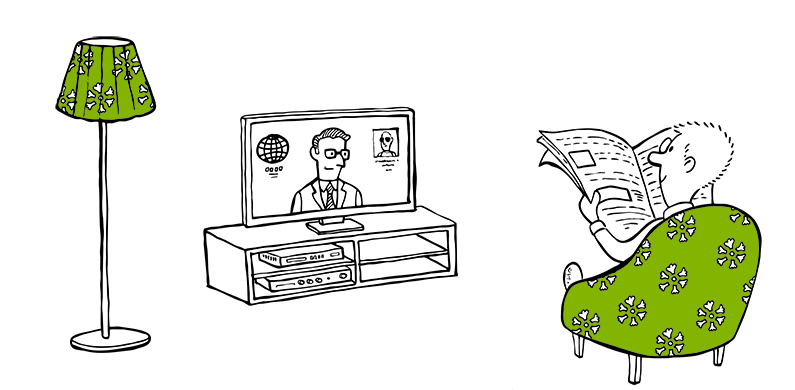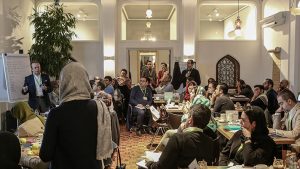
Forward Movement of dnaunion Group in Attracting Modern Businesses 
The dnaunion group held a press conference on August 4th (13 Mordad) titled “Innovation in Marketing: Strategies for Business Growth During Recession.” Present at the event were Naser Pashapour Niko, CEO of dnaunion group and recipient of the Excellent Entrepreneur Award; Gerhard Barkous, board member of dnaunion and CEO of Certius company; and Mohammad Mousavi, board member of dnaunion and CEO of Etteghat Tasvir agency.
At the meeting, Naser Pashapour Niko stated:
“In recent decades, digital transformations have changed the image of businesses worldwide. These changes have led to the creation of new brands and the disappearance of some powerful global brands. These transformations, which have sparked the web movement, began in the 1990s and are predicted to grow steadily until 2040. Currently, the digital era is in the midst of Web 3.0, an era where audiences, although living in the real world, spend hours in the digital world. Such changes have created a planet where all audiences are connected through information. In 2018, the average number of communication devices per person was 2.9, and by 2022, this number is expected to double. Thus, people today are easily connected to one another. In this world, content still plays a key role; however, the meaning of good content is fundamentally changing. Good content is now content that has the most viewers. Greater visibility connects us to vast information sources. This information allows audiences to be analyzed based on likes and the content they consume. Such analysis shifts classification from demographic characteristics toward classification based on analyzed behavioral patterns. Based on this, individuals’ behavioral patterns are identified and categorized into various groups. By 2030, this process is called ‘human hacking,’ when machines understand humans better than they understand themselves. Meanwhile, the concept of personal web arises. The impact of the personal web on marketing creates DNA marketing. In the future, people with similar patterns exhibit similar behaviors. Based on these behaviors, various marketing programs can be designed and predicted. Although currently experimental, these trends will soon materialize in the marketing industry. Campaigns will become more personalized and tailored to each individual’s needs.”
Trends in Online Business Transformation
Pashapour added:
“Currently, about 7,000 companies worldwide are active in this field. This wave of transformation has reached Iran as well. For example, a few years ago, online businesses such as Snap (Snapp), Divar, Digikala, etc., were not as prominent. Soon, more businesses will be affected by these changes. Overall, businesses need innovation to survive, and moving forward requires expert support. Every business in every market segment requires innovation.”
In this regard, EMRC (Market and Media Research Company) analyzed the transformation of online businesses from 2015 to 2018. Their study focused on the positioning of businesses among audiences. The research showed that in 2018, internet penetration reached 92% and mobile penetration 85%, representing growth rates of 49% and 70% compared to 2015 respectively. Dependency on the internet increased by 38%, and the percentage of people who cannot live without mobile internet rose by 84%. Influence by social media messages surged by 192%. Moreover, in 2018, 75% of society was under the influence of social networks. Currently, social network penetration is still rising, with Instagram reaching 56% penetration among social media users. High penetration and easy access to target groups have led to significant advertising investment in this space.
According to the research, 74% of citizens have made at least one internet purchase in the past 12 months. About 16% of the population made at least one purchase (online or offline) influenced by media advertising. The research also studied effective media channels: 43% of buyers influenced by advertising were impacted by social media.
This trend has increased app usage in daily life: 51% use social network apps, 51% music streaming apps, and 49% messaging apps.
Online businesses have found a suitable environment for growth amid the move to digital platforms. Online shopping platforms grew more than twice since 2015, and online taxi services grew 1.6 times since 2016.
Use of online services continues to rise. For example, in 2018, 56% of hotel guests booked online, 41% of air travelers purchased tickets online, and 48% used financial apps for online payments. Approximately 40% of the population shopped online, with cultural and artistic products (books, concert tickets, cinema, etc.) being the largest online purchase category at 39% in the past year.
The research further indicated that 74% of the population use at least one type of online service. In 2018, about 21% were users of payment applications or internet banking. Given the current economic recession, people have increasingly turned to online businesses to better manage expenses.
Responding to a question about changes in banking systems, Pashapour said:
“Iranian banks currently provide online services beyond those offered by banks in other countries. However, fully virtual banks are missing in Iran. Banks should reduce branch costs and move towards full virtual operation. Fintech companies can enable this transition. Although banking is more than fintech technology, banks currently possess the technology required to become fully virtual.”
Innovation Changes Business Models
Gerhard Barkous said:
“Fully online banks began operating in Europe twenty years ago. European customers trust these systems and have used them for years. Innovation in marketing has redefined business models. Brands like Snapp and Uber have redefined their industries. Today, all businesses see online businesses as competitors and collaborators. Banks are working toward European-style online systems. Fast-moving consumer goods companies in the UK have all activated their online branches and aim to convince consumers to buy online. The dnaunion group, through the launch of the Av Innovation Center, helps businesses compete digitally by digitizing and market-fitting their features. For example, owners now want to combine offline consumer behavior with online data to gain precise insights. Therefore, owners need accurate consumer behavior data both offline and online. The Av Innovation Center assists clients in three areas: first, helping businesses deliver digital services and receive better feedback; second, redefining business features for digital presence; third, supporting business model design in digital space.”
Barkous continued:
“In the digital world, competition is about correct pricing, allowing audiences to easily compare prices and choose services. This optimizes both consumer utility and business models. All businesses face initial challenges, but none can stop this inevitable transformation.”
Sanctions limit Iranian businesses’ access to many virtual space capabilities, yet businesses must utilize available tools.
Overall, the market where buyers have the final say will return. Winners will be those who complete their supply chains. The key point is that with reduced purchasing power, market size also shrinks. Businesses aim to gain larger market shares and will grow post-sanctions.
Significant Growth of Digital Advertising in Iran
Mohammad Mousavi said:
“Due to recent currency fluctuations, purchasing power has declined. According to EMRC research, some goods have been removed from households’ baskets while others have replaced them. People try to buy from channels offering cheaper goods and services. Online businesses play an important and growing role in this.”
Regarding digital advertising:
“Digital advertising currently accounts for about 4 to 6 percent of total annual advertising budgets. Online advertising has become popular due to the variety of channels and is growing rapidly. Its key feature is measurability; campaigns can be monitored and adjusted in real-time. However, big businesses have not yet significantly increased their digital ad budgets.”
On Iranian brands’ growth during sanctions:
“Some brands exit the market during sanctions, while others with stronger production capabilities introduce new products. This fills market and brand capacity gaps. This dynamic has also appeared in past sanctions. However, many Iranian brands have a short-term perspective, leading to short brand life cycles. With a long-term view, Iranian brands can succeed domestically and internationally.”
Regulatory Challenges for Online Businesses in Iran
Pashapour said:
“Multiple regulatory bodies pose challenges for online businesses in Iran. Online business advertising influence is increasing; for instance, advertising tariffs grew from 182 billion IRR in 2016 to 2,471 billion IRR in 2018 (based on six national TV channels, excluding contractual discounts and extra air time). Among online businesses, Rubika app held 79% of ad volume in 2018, while Iran Seda app had the highest tariff value. Comparing with 2016, the ‘Up’ app accounted for 27% of ad volume and 31% of tariff value. Forecasts suggest online advertising will account for 30% of total business advertising budgets in coming years.”
Currently, due to recession, many large businesses focus on producing new or maintaining existing products. Old brands prioritize production over advertising. Meanwhile, strong brands continue to launch products, fostering new brands and advertising opportunities.
When markets become competitive, buyers control the market. Brands with strong marketing foundations grow. Today’s market is not competitive but sales-driven, with suppliers dominating. Market nature has changed; brands that can supply products will remain.
Pashapour on Av Innovation Center’s recent activities:
“Currently, six ideas are underway at Av Innovation Center; two—Hapirad and Hapirmil—have launched, automating online ad buying and selling across all online spaces. Four other ideas, related to influencer marketing and monitoring offline ads online, will launch by year-end. These ideas cover AdTech, MarTech, and Market Research. We also assist fashion, automotive accessories, and household hygiene businesses entering digital markets, with announcements soon.”
The center also introduces university talent’s ideas to businesses. One successful project is Smart Lightning, developed by three youths, now in production. Despite a difficult year, growth opportunities exist; businesses have grown due to reduced competition, which will return. Companies must use this time to build infrastructure for competitive markets.
At the end of the press conference, dnaunion group honored several journalists in celebration of Journalist’s Day.





